After watching a discovery programme which featured
one person fibreglass yachts. I decided that I could
do something similar, but from wood. Being a keen
model builder, I had built a 30 inch yacht a few years
back and it was to form the basis of my 'full size'
version.
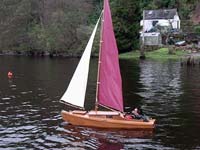 |
After watching
a discovery programme which featured one person
fibreglass yachts. |
I did a bit of measuring and came up with my scaleing
factor. My main restriction was that it had to fit
through my attic hatch! This set the beam and came
out at 7foot 8 inch length, sticking to the proportions
of the model.
| My main restriction
was that it had to fit through my attic hatch! |
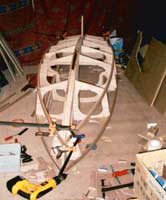
|
I spent a while drawing up my plans and then made
up a full size keel pattern and the biggest bulkhead
to make sure it fitted down the hatch, which it did!
I also redesigned the internal structure to allow
me to fit in it.
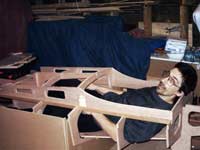 |
I redesigned
the internal structure to allow me to fit in
it. |
The wood was purchased and the project was under
way. I had to make the fin removeable to get the hull
down the hatch, as well as not letting in any water,
so it locates in a sealed slot that sits between your
legs and it is held in place with a 1/2 inch brass
peg through the top, above the deck.
| The fin locates
in a sealed slot that sits between your legs and
it is held in place with a 1/2 inch brass
peg. |
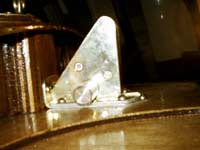
|
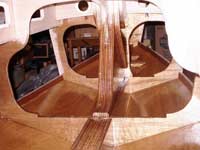 |
The fin housing. |
| Another view of
the fin and pin with the mast socket to the right.
|
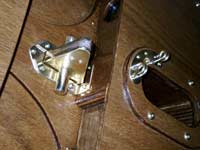
|
Steering took a while to work out and is operated
by a handle inside with pushrod activating the 3mm
thick brass rudder. The mast and booms are laminated
from mahogany floorboards then planed and sanded to
shape, with fittings made from brass rod and stainless
welding rods. Sails are homemade from nylon and are
controlled by two lines running back to the cockpit.
From the tip of the mast to the bottom of the fin
is 15 feet.
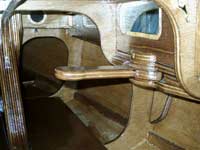 |
Steering took
a while to work out and is operated by a handle
inside with pushrod activating the 3mm thick
brass rudder. |
| Top view of steering
handle and push rod. |
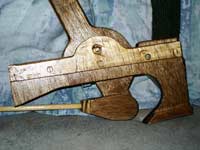
|
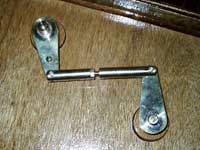 |
Rudder transfer
linkage |
The lead keel bulb halves were cast in sand after
impressing the shape with a blue foam plug reinforced
with a pair of tights stretched over and painted with
pva glue to give it a tough surface. I melted the
lead in a gallon paint tin on a bonfire and when I
went to lift it, I couldn't work out why it was stuck
to the ground! It was only when I weighed the halves
later, 50lbs each,that I realised that I had been
trying to lift about 80lbs of lead with one hand on
a set of molegrips and a towel wrapped round it to
protect me from the heat. When they were cool, I drilled
holes for bolting them to the fin. I recessed the
bolt heads by drilling with a flat spade bit, if you
have never drilled lead with a spade bit, don't be
too keen to try it as it tries to twist your wrist
off!
| The lead keel bulb
halves were cast in sand after impressing the
shape with a blue foam plug. |
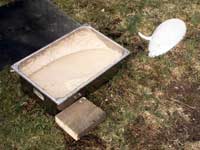
|
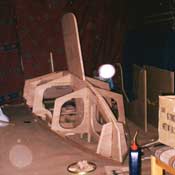 |
When they were
cool, I drilled holes for bolting them to the
fin. |
When the fin was complete with lead bulbs it weighed
108lbs. The rest of the boat and masts etc weighed
about 95 lbs. I could probably lose a bit of lead
off the bulbs but I like knowing it's not just going
to fall over when the wind gets up!
On it's maiden voyage I had 18 spectators who I suspect
only turned up in case it sank. Half of them had gone
home by the time I got back from my hour long voyage!
I enjoyed the build and the sailing, even though there
was not very much wind. I had also made up a spray
cover/hood which is shown on the sailing photos, but
I didn't need it due to the calm weather. I have been
into motorbikes for years and was amazed to be moving
under power with no noise, a strange but nice sensation.
| On it's maiden voyage
I had 18 spectators who I suspect only turned
up in case it sank. |
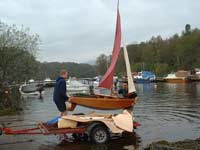
|
The only problem I had was that I launched in an
area that was sheltered from the wind and could not
maneuver out of the boatyard, this led me to think
about auxilliary power. I got hold of an electric
outboard and tried to think of a way to use it on
the yacht,but as it hadn't been designed in ,there
was no place for it or the battery, so I left it as
it was and started designing the Viper miniboat instead.
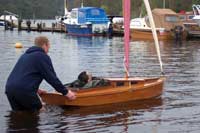 |
I had made
up a spray cover/hood, but I didn't need it
due to the calm weather. |
I tried to sell the yacht on Ebay to fund the Viper
but never got any bids. There were over 25 people
watching it and I had over 800 hits but no sale. I
built it to last a while, using marine ply and 6 coats
of varnish, I asked the wife if I could keep it in
the living room but for some reason she wasn't into
that! I thought it would make a nice ornament or an
unusual sign for a yacht club, or a rich mans pool
toy but I had no takers.
| I asked the wife
if I could keep it in the living room but for
some reason she wasn't into that! |
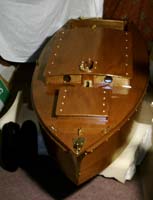
|
It was a slightly strange idea for a project but
I am glad I made it. I took over 400 photos as I was
building it and 3 different people took photos of
the launch,I enclose a small selection of them. It
turned out to be cheaper to build than some of the
models I have made! Hope you like it.
Andy M.

|